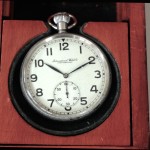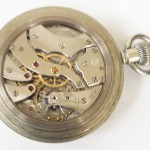The Calibre 67 movement was made from 1933 to 1958 in 23,400 examples. it debuted at an unfortunate time, at the height of the Great Depression and during an era that pocket watches were sold less due to the ascendancy of the wristwatch.
This Calibre s frequently found in less expensive pocket watches, usually steel cased. While it might be considered as a less expensive model, it still is a fine movement and in fact the design serves as a predecessor for IWC’s more contemporary Calibre 98 movements. It also is frequently found in military-styled steel-cased pocket watches, and in fact was used by the German Navy as a deck watch in World War II
Calibre 67 is 5.5 mm in height, and has a diameter of 41 mm (18 ligne). It was produced in 15 or 16 jewel variations. As with other IWC pocket watch movements that preceded it in the late 1920s and ’30s, it beat at the traditional 18,000 half-beats per hour (2.5 Herz), had a bimetallic balance with screws, a hair-spring with a Breguet overcoil and used a so-called goose-neck (or Swan’s neck) fine-adjustment for regulation.
This Calibre 67 watch from 1944 is a classic example of a military deck watch with its dial format and design. The case is oversized, and the dial is luminous but not radioactive. This watch was used by the German Navy (Kriegsmarine) of U-boats and surface boats in World War II. It presumably has been “de-Nazified” since the K.M. (for Kriegsmarine) is not on the dial, and a National Socialist swastika emblem is no longer engraved on the back of the case. These de-Nazified watches then were used by the German Federal Navy after 1955.
The movement of this Calibre 67 reveals a serial number that shows that it was produced in 1944 for Gerl & Schipper, the supplier of these watch to the Kriegsmarine. One can see that the movement was not decorated, but has fine regulation. Comparing it to ;later IWC production, layout of the bridges reflects a striking similarity.



